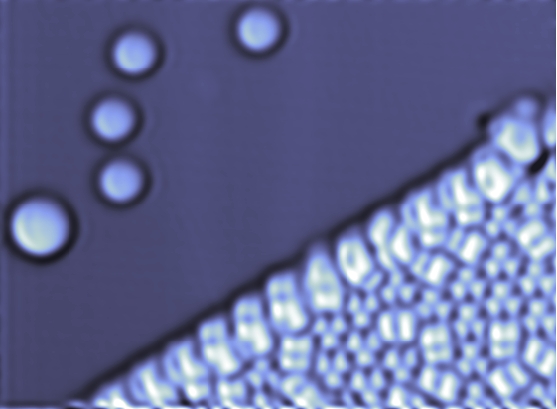Molecular Currents
European researchers have measured the electrical conductance between a single pair of precisely oriented molecules. In the 13 November Physical Review Letters they describe picking up one molecule on the tip of an ultrafine scanning-tunneling-microscope probe and monitoring the current when it is positioned over another molecule. Understanding and controlling electric current between neighboring molecules will be important if electronic circuits are to be built using individual molecules.
For the ultimate in miniaturization, researchers want to learn all they can about using molecules in electronic circuits. They have measured currents between molecules but not with a precise understanding of the configuration and positions of the molecular electrons.
To explore molecular conduction in greater detail, a team led by Richard Berndt of the University of Kiel, Germany, worked with spherical “buckyballs.” They first scattered the molecules onto a pristine gold or copper surface, which generated single-molecule-thick regions interspersed with voids of bare metal. They then picked up a single molecule on the tip of the needle-like probe of a scanning tunneling microscope (STM) and scanned the probe across the surface in the usual imaging mode. This procedure allowed stray, isolated metal atoms on the surface to act as “upside down” STM probes that provided detailed images of the suspended buckyball from underneath. In the images, the ordinarily spherical atoms show up in the shape of the buckyball. The team used these images to map the detailed orientation and electronic structure of the buckyball.
The researchers then measured the conductance (the inverse of resistance) for current flowing from the probe through the buckyball and into the metal surface. This measurement was tricky because the current and the conductance continue to increase as the probe moves closer to the surface, with no clear moment when the buckyball is touching but not “squishing” against the surface. For several molecular configurations, the team chose a representative point on the conductance curve using a method similar to previous experimenters and found that the largest value was about three times as big as the smallest value. It depended roughly on how many metal and atoms were in contact, and the team explained these variations by comparing them with detailed calculations. The conductance values were not far from the ideal value for a perfect quantum channel where e is the electron charge and h is Planck’s constant, or about 1/(13 kilo-ohm)).
To measure the current between molecules, they moved the suspended buckyball over other buckyballs. The resulting current had to flow from the metal probe through one molecule, then through the second molecule to the metal surface. For two molecules in this arrangement, the maximum current was 100 times smaller than for a single molecule. Team member Guillaume Schull, now at the Strasbourg Institute for Materials Physics and Chemistry (ICPMS) in France, traces this lower current to the poor electronic interface between buckyballs. “The bonding between these two molecules is really bad. There is no chemical bond when we approach one to the other,” he says. In fact, if the researchers try to push them any closer than their separation in crystals, the bottom molecule simply slides sideways, so the current doesn’t increase.
Nonetheless, the experiments give very detailed information about conduction between molecules. “[With our technique] we can play with the distance between the molecules or the molecular orientation,” Schull says. “All of these parameters are really vital for understanding how this would work at a bigger scale.” Paul Weiss, of the University of California, Los Angeles, agrees that measuring conduction between molecules is important. “If we’re ever going to make devices out of molecules,” he says, “we need to know how they couple,” both for desired connections and for undesired “cross-talk” between neighbors.
–Don Monroe
Don Monroe is a freelance science writer in Murray Hill, New Jersey.





